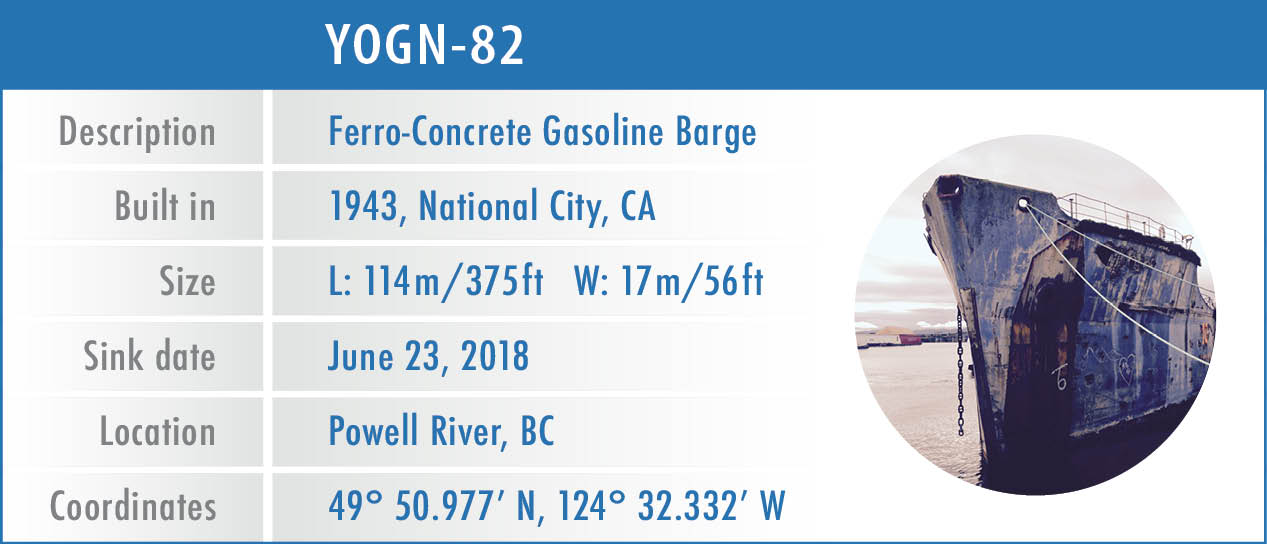FIRST OF THE CATALYST HULKS BECOMES AN ARTIFICIAL REEF • POWELL RIVER, BC • 23 JUNE, 2018
On a sunny Saturday morning, spectators started gathering at Willingdon Beach in Powell River to witness a significant change to their seascape: the federal government approved sinking of the first of the breakwater ships from Catalyst Paper to be re-purposed to create a new marine habitat.
At 10:15 am, YOGN-82 could be seen under tow on approach to the designated sink zone, located about half way between the Catalyst Mill site and Willingdon Beach. By 11:25 she was being held in position by two support tugs. At 11:56 spectators on shore and in boats witnessed the detonation of high explosives onboard the hulk that pulverized holes in the 5½ inch thick hull of reinforced concrete, letting water in to flood the barge. This blast started YOGN-82 on her final 11-minute voyage – to settle quickly and gracefully on the seabed, upright and fully intact, at a depth of 90 to 100 feet.
YOGN-82 has been part of the mill’s 10 vessel breakwater grouping since 1961 and is the first of four vessels which, thanks to Catalyst's consultation with the Reef Society, will transform a group of American-built WW2 II ferro-concrete barges into new marine habitat and a recreational dive destination. Already there’s been keen interest from within the dive community by divers eager to visit this icon of maritime history. Divers were allowed to start exploring the wreck site on Sunday 24 June and the first tour took place on Monday 25 June.
Catalyst Management commented in their press release of 23 June that, following YOGN-82, the company will continue working with the ARSBC to reef three more barges (Emile N. Vidal, Quartz and SS Peralta) over the next five years. Details of these follow-on projects will be posted as timelines are established.
– Rick Wall, Vice President, ARSBC (27 June 2018)
On a sunny Saturday morning, spectators started gathering at Willingdon Beach in Powell River to witness a significant change to their seascape: the federal government approved sinking of the first of the breakwater ships from Catalyst Paper to be re-purposed to create a new marine habitat.
At 10:15 am, YOGN-82 could be seen under tow on approach to the designated sink zone, located about half way between the Catalyst Mill site and Willingdon Beach. By 11:25 she was being held in position by two support tugs. At 11:56 spectators on shore and in boats witnessed the detonation of high explosives onboard the hulk that pulverized holes in the 5½ inch thick hull of reinforced concrete, letting water in to flood the barge. This blast started YOGN-82 on her final 11-minute voyage – to settle quickly and gracefully on the seabed, upright and fully intact, at a depth of 90 to 100 feet.
YOGN-82 has been part of the mill’s 10 vessel breakwater grouping since 1961 and is the first of four vessels which, thanks to Catalyst's consultation with the Reef Society, will transform a group of American-built WW2 II ferro-concrete barges into new marine habitat and a recreational dive destination. Already there’s been keen interest from within the dive community by divers eager to visit this icon of maritime history. Divers were allowed to start exploring the wreck site on Sunday 24 June and the first tour took place on Monday 25 June.
Catalyst Management commented in their press release of 23 June that, following YOGN-82, the company will continue working with the ARSBC to reef three more barges (Emile N. Vidal, Quartz and SS Peralta) over the next five years. Details of these follow-on projects will be posted as timelines are established.
– Rick Wall, Vice President, ARSBC (27 June 2018)










